MAI kinetic energy storage device – new emergency power supply source
Scientists of the department 310 "Electric power, electromechanical and biotechnical systems" MAI developed superconducting kinetic energy storage device (KNE). Its efficiency is almost 100%.
The project was noted at the XLVII International Youth Scientific Conference "Gagarin Readings", as well as at the European Conference on Applied Superconductivity EuCAS-2021. The press office of Moscow Aviation Institute talked to the team of developers and found out what is special and unique about the device.
Applicability
Kinetic energy storage device is the energy storage device that converts mechanical energy from the rotating flywheel into electrical energy from the motor generator.
KNE are used as emergency power sources, auxiliary power source during peak loads on the power grid and in power supply systems based on renewable energy sources.
As Konstantin Kovalev, the project manager, Doctor of Technical Sciences, Professor of Moscow Aviation Institute, says, the superconducting kinetic energy storage device is a promising development in the area of electromechanics:
– It is able to replace the existing emergency power supplies – diesel generators, as it surpasses them in terms of efficiency, reliability, durability and environmental friendliness, – he concluded.
Uniqueness
The uniqueness of the device is in the storage mechanism itself: young scientists used magnetic suspension, superconducting bearings, “ironless” motor-generator, and vacuum-evacuated KNE body. This design minimizes electrical and mechanical losses, as well as eliminates the friction of the rotating parts against air, which makes it possible to achieve the efficiency of 99.99%.
– This device uses high-temperature superconducting bearings, which are completely free of friction. Energy losses of any electromechanical device represent the sum of losses, namely: losses in steel - hysteresis losses, losses in copper and mechanical losses - due to friction in bearings, – explains one of the authors of the project, graduate student of the department 310 Vladimir Podguzov. – We got rid of hysteresis losses by making the stator of the motor-generator “ironless”.
There are no analogues to the MAI development on the Russian market. The young scientists are planning to carry out the full cycle of tests of this device and prove its efficiency.
It is necessary to pump the air from the KNE body and create vacuum there – then, according to the authors, it is possible to achieve the nominal flywheel speed of 8000 rpm without heating the rotating parts due to friction against the air, while in air the flywheel temperature reaches critical indicators after 5000 rotations already.

